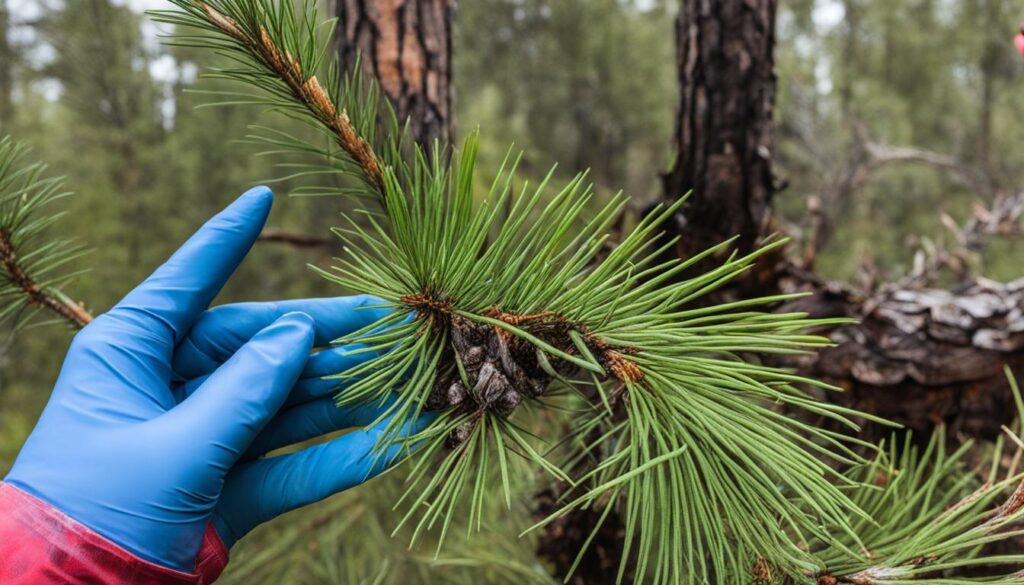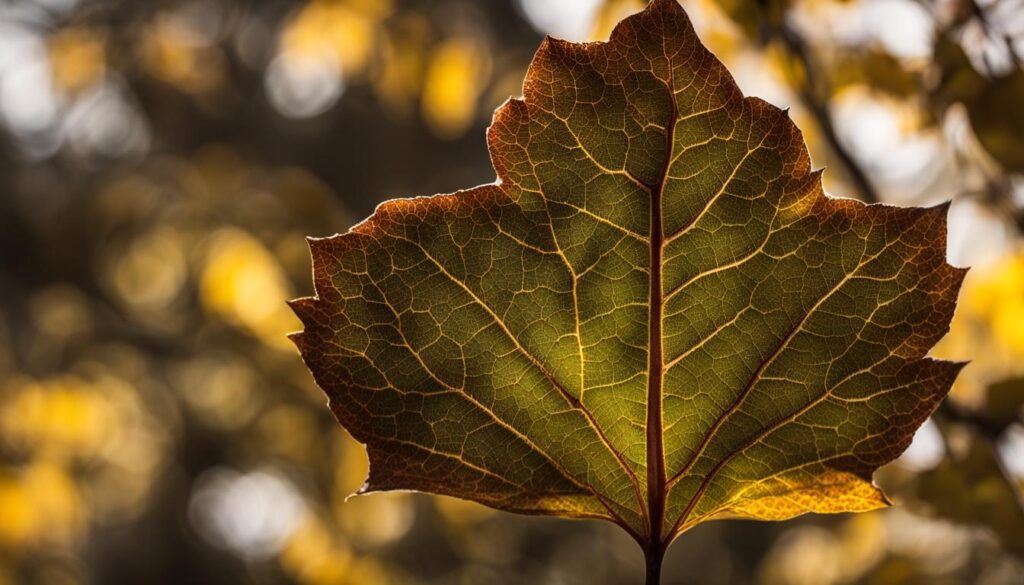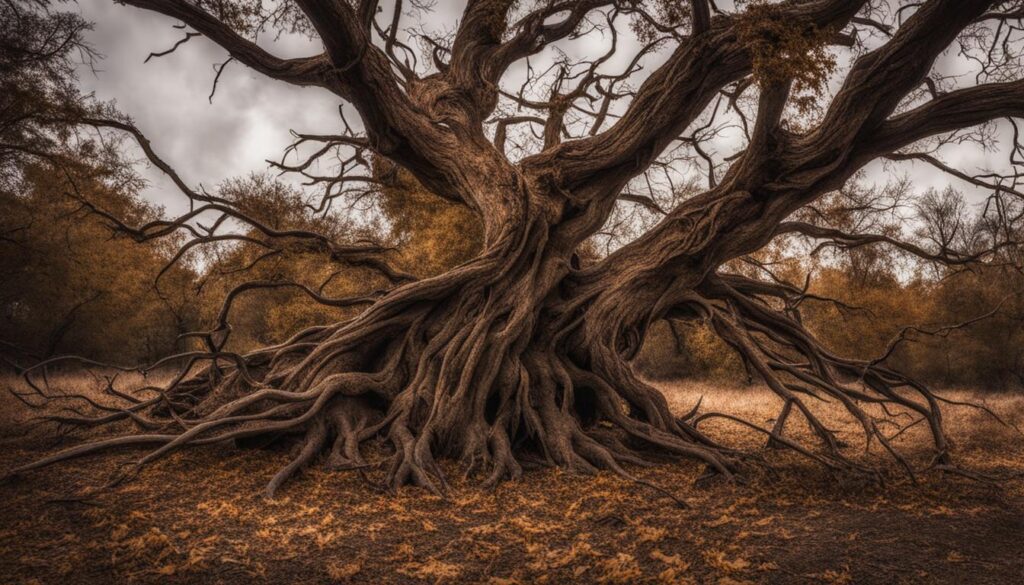Welcome to my article on pine tip blight disease treatment. If you have pine trees on your property, you may already be familiar with the challenges posed by this common disease. Pine tip blight, caused by the fungus Diplodia pinae, can lead to the disfigurement or even death of pine trees if left untreated. But the good news is that there are effective solutions available to combat this problem.
Pine tip blight disease is characterized by symptoms such as stunted and yellowing needles, resin droplets on needles and shoot tips, branch flagging, large branches dying, and resinous cankers on larger branches. The fungus Diplodia pinae survives in infected shoots and branches, spreading through spores that are dispersed by water and wind. However, there are proactive steps you can take to reduce the likelihood of infection and effectively manage this disease.
Key Takeaways:
- Proper tree care and irrigation during drought can help prevent pine tip blight infections.
- Pruning and sanitation are effective methods for controlling the disease.
- Fungicide applications may be necessary for severe infections.
- Symptoms of pine tip blight can be differentiated from other problems like environmental stress or pine tip moth damage.
- Maintaining overall tree health is crucial for preventing pine tip blight.
Understanding Pine Tip Blight Symptoms
Diplodia tip blight and canker primarily affect mature pine trees. The disease commonly manifests its symptoms in the spring, as new needles emerge and elongate. The first sign is the stunted growth of the needles, which turn yellow and eventually brown. Another noticeable symptom is the presence of white resin droplets on the affected needles and shoot tips. As the disease progresses, it can invade the tree’s twigs, leading to branch flagging. Over time, larger branches may die, and resinous cankers may become visible on them. Additionally, fruiting structures can develop on pine cone scales, further indicating the presence of pine tip blight.
In order to address and effectively treat pine tip blight, it is crucial to accurately identify the symptoms and their severity. Understanding these symptoms is essential for implementing the appropriate treatment strategies and preventing further damage to the pine trees.
Understanding the Disease Cycle of Pine Tip Blight
Pine tip blight and canker are caused by the fungus Diplodia pinae. The fungus survives in infected shoots, branches, and pine cones and produces spores that are dispersed by water and wind. These spores play a crucial role in the disease cycle of pine tip blight, spreading the infection to new pine needles.
The spores can enter the new pine needles through stomata, which are small openings on the surface of the needles that regulate gas exchange. Alternatively, they can also enter through wounds and cracks in the bark of the tree.
Infections occur when there is free moisture, making the disease more severe in years with rainy springs. Rainfall provides the necessary conditions for the spores to germinate and infect the susceptible pine trees.
It is important to note that pine tip blight can also exhibit latent infections. This means that the tree may be infected, but symptoms may not appear immediately. In some cases, symptoms may manifest several months or even longer after the initial infection.
Effective Management Strategies for Pine Tip Blight
Proper tree care is crucial for managing and minimizing the impact of pine tip blight. By implementing the following strategies, you can effectively control and prevent the spread of this disease:
1. Tree care and irrigation
Ensuring proper irrigation, especially during periods of drought, can significantly reduce the likelihood of Diplodia tip blight infections. Providing adequate moisture to the tree’s root system helps maintain its overall health and resilience.
2. Pruning and sanitation
Pruning and sanitation practices play a vital role in controlling pine tip blight, especially when trees are newly infected. It is crucial to remove diseased shoots as soon as they are noticed, making cuts into healthy wood. This helps prevent the spread of the disease to other parts of the tree.
3. Fungicide applications
In severe cases of pine tip blight infections, fungicides containing copper hydroxide can be applied early in the spring and at regular intervals to prevent new infections. Timely and proper application of fungicides can help control the spread of the disease and protect the health of pine trees.
By implementing these management strategies, including proper tree care, irrigation, pruning and sanitation, and fungicide applications when necessary, you can effectively manage and reduce the impact of pine tip blight.
Differentiating Pine Tip Blight from Other Problems
Pine tip blight can sometimes be mistaken for other problems such as environmental stress or pine tip moth damage. Environmental stress factors like drought or winter damage can exhibit similar symptoms, but with environmental stress, the shoots are often killed before new needles start to emerge.
Pine tip moths, on the other hand, hollow out the tip of pine shoots, leaving a distinctive hollowed-out area. This can be differentiated from tip blight, which typically presents with stunted and discolored needles, resin droplets, and branch flagging. Identifying the correct cause of the symptoms is crucial in implementing appropriate treatment strategies.
The Importance of Healthy Tree Care for Prevention
Maintaining the overall health of pine trees is crucial for preventing pine tip blight. Proper tree care, including irrigation during periods of drought and routine fertilization, can reduce the tree’s susceptibility to infections. Keeping the trees in good health and ensuring they receive the necessary nutrients can strengthen their defenses against diseases like Diplodia tip blight.
Regular monitoring and prompt action can help prevent the spread and severity of the disease. By implementing effective treatment strategies and maintaining healthy tree care, it is possible to safeguard pine trees from this damaging condition.
Pruning and Sanitation for Pine Tip Blight Control
Pruning and sanitation practices are crucial for effective control of pine tip blight. When dealing with newly infected trees, it is essential to promptly remove diseased shoots to prevent further spread of the disease. To ensure proper removal, pruning cuts should be made into healthy wood, at least 8 inches below the visible damage.
Pruning should be conducted during dry weather to minimize the risk of disease transmission. After each cut, it is important to clean pruning tools thoroughly with a household disinfectant to prevent contamination. This step helps prevent the introduction of the fungus to healthy parts of the tree.
Proper disposal of diseased clippings is equally important to prevent the spread of pine tip blight. The clippings should be burned or disposed of in the trash, ensuring they are kept away from healthy trees and vegetation.
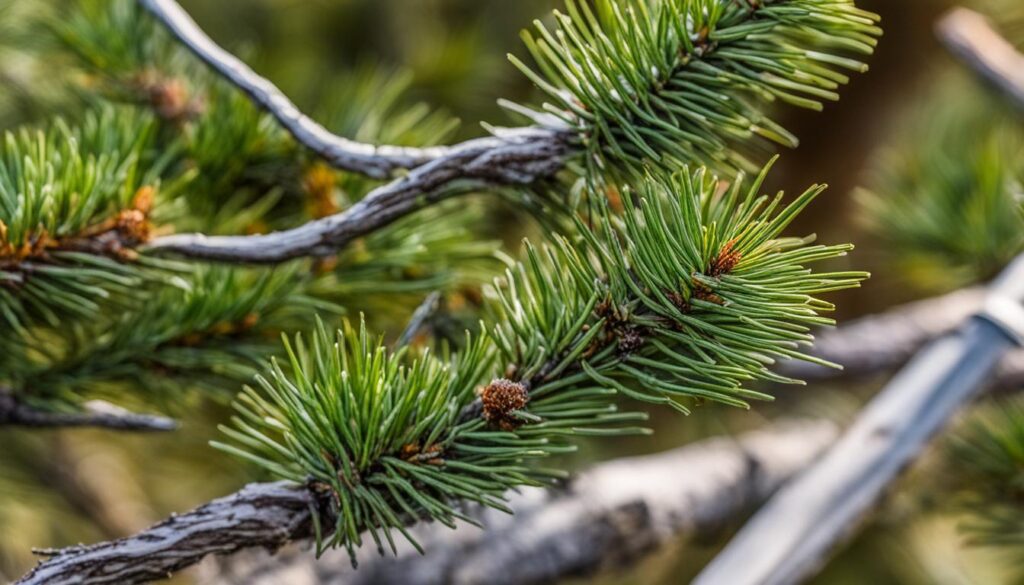

Fungicide Applications for Severe Infections
In cases of severe pine tip blight infections, fungicides may be necessary to control the disease. Fungicides containing copper hydroxide are commonly used for this purpose. They should be applied early in the spring as the buds open, and additional applications may be needed as the needles elongate. The timing of the applications is crucial for effective control. Home gardeners may need to hire professionals to ensure adequate spray coverage, depending on the size of the tree.
Applying Fungicides for Pine Tip Blight
When dealing with severe pine tip blight infections, the application of fungicides becomes essential to combat the disease effectively. Fungicides containing copper hydroxide have proven to be effective in controlling pine tip blight. The recommended timing for application is early spring when the buds start to open. This is when the disease is most vulnerable, and targeting it at this stage can prevent further spread. Additional applications may be required as the needles elongate to ensure continued protection.
The key to successful control lies in the proper timing of fungicide applications. Applying the fungicides too early or too late may yield ineffective results. It is crucial to closely monitor the development of the disease and adhere to the recommended application schedule.
Ensuring Adequate Spray Coverage
Proper spray coverage is essential to ensure the fungicides reach all areas of the tree affected by pine tip blight. The size of the tree may determine whether homeowners can achieve adequate coverage on their own or need to enlist the help of professionals. Smaller trees can typically be adequately covered with commercially available sprayers. However, larger trees may require specialized equipment and professional expertise to ensure thorough and even coverage.
Consulting Local Extension Offices for Recommendations
When it comes to managing pine tip blight, it is highly recommended to consult with your local county Extension office for specific recommendations. These offices are valuable resources that can provide you with up-to-date information on the most effective fungicides for your area. They can also offer expert advice on proper tree care and management strategies tailored to the local conditions.
By contacting your local Extension office, you can benefit from obtaining the most relevant and accurate information for managing pine tip blight. Their expertise and knowledge will help you make informed decisions and take the necessary steps to combat this damaging disease.
Don’t hesitate to reach out to your county Extension office for guidance and recommendations.
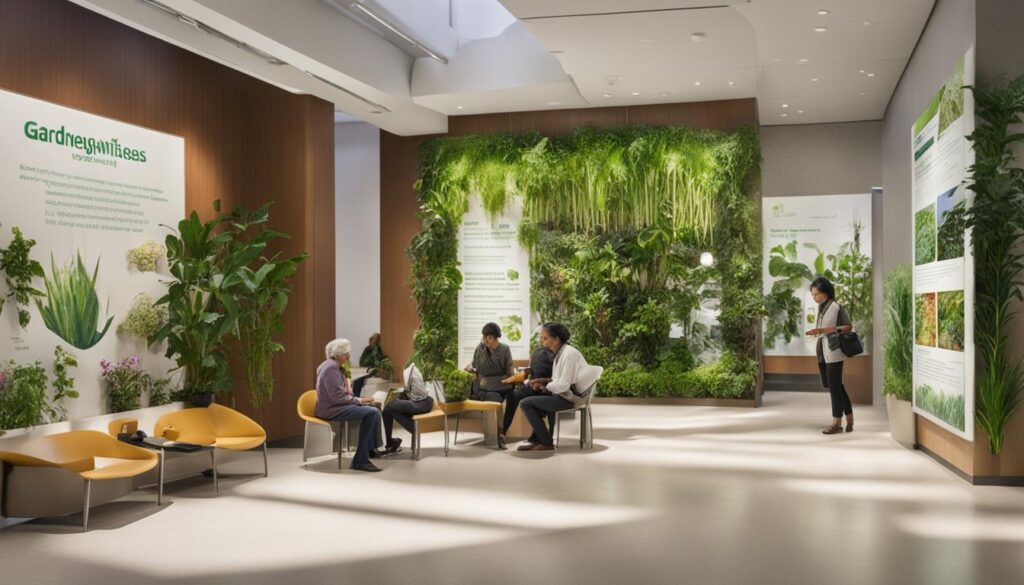

Conclusion
Pine tip blight is a disease that can have devastating effects on pine trees if left untreated. However, with proper tree care and effective treatment strategies, the impact of this disease can be minimized, allowing you to safeguard your pine trees from further damage.
One of the crucial steps in preventing the spread and severity of pine tip blight is regular monitoring. By frequently inspecting your pine trees for any signs of infection, such as stunted and yellowing needles, resin droplets on needles and shoot tips, or branch flagging, you can take prompt action and implement the necessary treatment measures to protect your trees.
Proper tree care practices, including irrigation during drought, pruning, and sanitation, are essential in managing and controlling pine tip blight. Ensuring your pine trees receive adequate water during dry periods can help strengthen their resistance to infections. Pruning infected shoots, making cuts into healthy wood, and practicing proper sanitation by cleaning pruning tools between cuts can effectively limit the spread of the disease.
In severe cases, the application of fungicides containing ingredients like copper hydroxide may be necessary. These fungicides should be applied at the appropriate timing, preferably early in the spring, and at regular intervals. Adequate spray coverage is crucial for effective control, particularly for larger trees, where professional assistance may be needed.
By following these treatment strategies and maintaining healthy tree care practices, you can minimize the impact of pine tip blight and safeguard your pine trees from this damaging condition. Remember, regular monitoring and taking prompt action are key to keeping your trees healthy and protected.
FAQ
What are the symptoms of pine tip blight?
Symptoms of pine tip blight include stunted and yellowing needles, resin droplets on needles and shoot tips, branch flagging, large branches dying, and resinous cankers on larger branches.
What causes pine tip blight?
Pine tip blight is caused by the fungus Diplodia pinae, which survives in infected shoots and branches and spreads through spores dispersed by water and wind.
How can I manage pine tip blight?
Proper tree care and irrigation during drought can reduce the likelihood of infections. Pruning and sanitation are effective methods for control, and fungicide applications may be necessary for severe infections.
How can I differentiate pine tip blight from other problems?
Pine tip blight can be differentiated from environmental stress or pine tip moth damage by looking for specific symptoms. Environmental stress kills shoots before new needles emerge, while pine tip moths leave a hollowed-out area in the tips of pine shoots.
What are the key strategies for preventing pine tip blight?
Maintaining overall tree health through proper care, irrigation during drought, and routine fertilization can help prevent pine tip blight. Regular monitoring and prompt action are also important in preventing the spread and severity of the disease.
How can I control pine tip blight through pruning and sanitation?
To control pine tip blight, remove diseased shoots as soon as they are noticed by making cuts into healthy wood. Prune during dry weather to prevent disease spread, and clean pruning tools between cuts to avoid spreading the disease.
Is fungicide application necessary for severe pine tip blight infections?
In cases of severe infections, fungicides containing copper hydroxide may be necessary. They should be applied early in the spring and at regular intervals to prevent new infections. Home gardeners may need professional help depending on the tree’s size.
Where can I get specific recommendations for pine tip blight treatment in my area?
It is recommended to consult local county Extension offices for specific recommendations on pine tip blight treatment. They can provide up-to-date information on recommended fungicides and offer advice on tree care based on local conditions.

